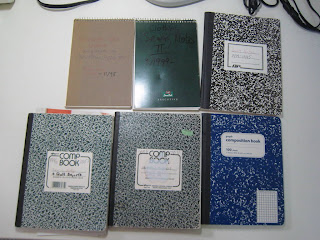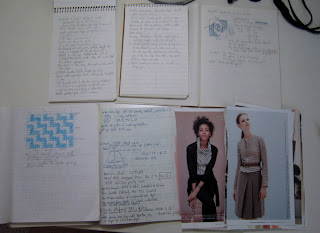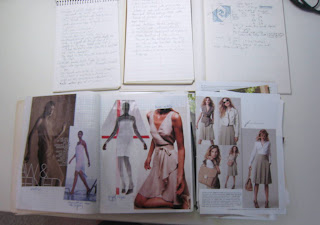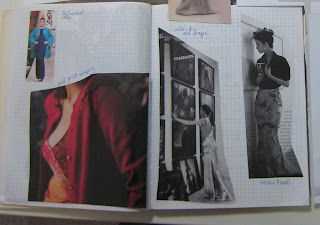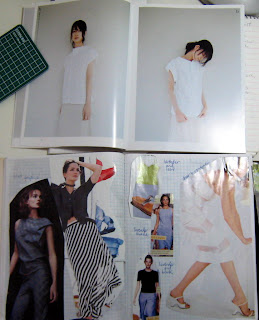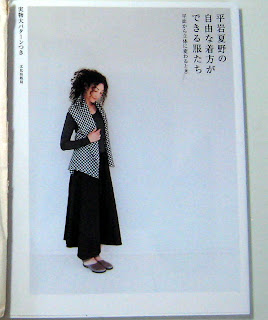While I slaved away on the home front, Bad Dad took the car for a wash, hunted and gathered groceries, took Iris to CTY camp registration, bought her textbooks and supplies and coordinated camp carpool plans. They are now at a classic film screening. He signed them both up for a Last Remaining Seats, a summer classic film series in "movie palaces of downtown L.A.'s Broadway Historic Theatre District." They have returned. It's official. She is as squeamish about Sunset Boulevard as I am. Anyone who takes a 10 year old to see Sunset Boulevard deserves the Bad Dad moniker, n'est pas?
I took advantage of the time alone to inventory their clothes and make up a shopping list, mending pile and sewing plan. They're actually not that long.
I had inventoried my own clothes before the trip, bringing a suitcase of clothing to friends in Boulder who would provide a better use for some of my clothes.
The arms of Big Apple Cardigan and Wren grew while I wore them. I felt like I Alice in Wonderland during her shrinking phase as my hands retreated into the sleeves. Those two cardigans look so much better on their new owner, a 15-year old competitive swimmer with her big shoulders and long arms.
Similarly, sweaters whose sleeves had shrunk look much better on a petite friend. I also left her the Leaf Yoke Ensemble and Katrina Rib. My closet feels so much lighter.
Anyway, I've been mulling over a couple of things my daughter said about our fashion differences.
First, she said that I should wear my shirts untucked. I remember having this discussion, at a similar age, with my own mother. She prefers her shirts untucked. I asserted myself by tucking in my shirts. Now my daughter is asserting herself by not tucking her shirts. This must be a generational thing because a friend says that her kids tell her that shirts shouldn't be tucked.
The second thing is a bit more serious. She remarked that there is such a time lag between my sewing plans and actual production, that the clothes will have gone out of fashion by the time I finish them. Thus, one needs to buy trendy clothes quickly, before they fall out of fashion.
NOOOOOOOOOOOOOOOOOOOOOOOOOO!
I do not want to participate in fast fashion, where kids toil to make t-shirts for other kids (Gap), or the garment workers are locked into the factories (like just about every cheap mass-market retailer) or the workers have to sue just to get paid their wages (Forever 21). This blog is about the antithesis to fast anything. We make everything from elemental carbon and water in this household*.
This is one reason I signed up for Wardrobe Refashion, a program where people commit to not buying mass-market clothes. It's like Weight Watchers for people who over-consume clothing because you get to buy one new item every two months, like WW food points. Exceptions are made only for clothes needed for work. Thus, WR forces people to rethink their consumption patterns to only what they really need, what they can find used, or what they can make.
She was just upset because I sewed a bunch of things for her in January and February, and then went on strike until June. I was upset to see the things I had laboriously made for her thrown on the floor in a trampled mess. I decided to behave more like The Selfish Seamstress until her behavior shaped up.
I broke the strike with a tunic for her made out of a skirt I bought from Goodwill two summers ago. I was going to turn this skirt into a pillowcase when she intercepted and said that she wanted it for a sundress. Two years of growth later and the skirt only stretches to tunic length. So perhaps her criticism about my sewing production rate was legitimate.
She has issued a press embargo on her clothes until she has debuted them in front of her friends. Thus, I cannot show the tunic, which we both think is the cat's meow.
Luckily, I am a year behind in blogging about the clothes I have already made for her. So I will show you another item I made from

*This is an old affectionate joke about UC Berkeley synthetic organic chemistry professor, Henry Rapoport. He was a spatial genius. In lecture, he used to switch writing hands to give the audience a better view of the blackboard. When he was trying to explain a complex reaction, he used to write with both his left and right hands simultaneously. Try taking lecture notes in his class!











